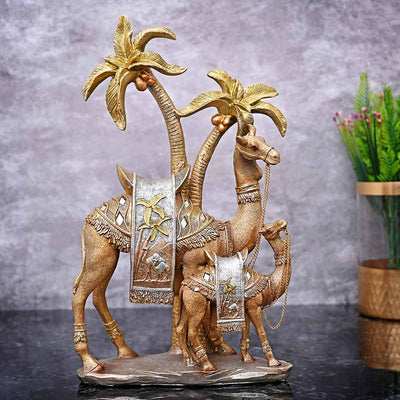Embellish your home walls with handmade Pichwai Paintings
India is a land of vibrant culture, rich heritage and tradition. And it is no surprise that a land imbued with great cultural diversity has many folk art traditions and crafts to admire. Each state and region has folk paintings and ways of preserving local art forms. The distinctive characteristics of Indian folk art include kaleidoscopic colours, intricate motifs, and the inclusion of mystical, natural and religious elements.
These incredible traditional folk arts play a significant role in showcasing India's ethnically diverse culture and heritage. One such art form is the highly meticulous handmade Pichwai (Pichwai) Paintings of Nathdwara, Rajasthan.
Let’s take a deep dive into the world of Pichwai paintings and learn why they deserve to be on your home décor list.
What is a Pichwai Painting – its history and origin?
To put it simply, the word Pichwai originates by conjoining the two Sanskrit words Pichha (Back) and Wai (Hanging). Hence, Pichwai means "that which hangs from the back". The painting's origins date back to the 17th century when the famous Srinathji Temple was established in the holy city of Nathdwara, approximately 45 KMs away from Udaipur, Rajasthan. The paintings were initially used to adorn the walls behind the idol of Srinathji, who is said to be a seven-year-old incarnation (Bal Swaroop) of the Hindu deity Lord Krishna.
Back in the day, the chief priest – Vithalnatha, employed several artists to embellish the walls of temples with Pichwai paintings. The intricate and aesthetically pleasing illustrations narrated Lord Shri Krishna's various episodes (leelas). The artworks further reflect the different emotions and expressions of Lord Krishna and mostly exhibit temple rituals like Shrinathji's ornamentation (Sringaar). The remarkable and monumental Pichwai paintings served a dual function. First – the paintings were used for embellishing the walls of the temple. Second, they were used as a vehicle to disseminate narrative and religious teachings about the life of Lord Krishna to folks who could not read.
What are the illustrations portrayed in Pichwai Paintings?
The overarching theme in Pichwai paintings is that of Lord Krishna. The traditional depiction of a Pichwai painting reflects the various seasons/festivals of a Pushtimarg religious calendar. Hence, the images portray Janamashtami (the birth of Shri Krishna), Gopashtami (Krishna's father, Nanda Maharaja, granted him the duty of caring for the cows of Vrindavan), Sharad Poornima, Anakoot festival (the painting depicts Lord Krishna as a saviour), and Holi. In addition, the images also show the majestic Chappan Bhog (a platter of 56 delicacies), which is a typical representation of Krishna that can be found. Moreover, the Rasleela, in which Krishna dances with Gopis, also found its depiction in the paintings. With time, the contemporary Pichwai images feature more natural symbols and motifs like the ornamental peacock, the blooming lotus, vines and even Krishna's adored herd of cows.
How is a Pichwai Painting made?
A traditional form of Pichwai style painting commands artisans to use only naturally derived materials to create dyes for colouring the paintings. The paint brushes are made from tail hair of horses and goats, coconut husks and slender tamarind branches. First the illustrations are drawn with hands on a handspun cotton based canvas. It is done with extreme precision and attention to details. Once a brilliant silhouette comes alive on the canvas, it is prudently filled with colours to give the final look. The complexities of design can make the colouring challenging even for a skilled artist. The prominent hues that are present in Pichwai Paintings are charcoal, red, gold, orange, indigo and green. The naturally derived organic colours like a golden hue from real gold can take up to 3-4 days to make! Sometimes precious stones and gems are also used to ornate the paintings.
Depending upon the detailing and fineness of the work, the time taken to complete the painting can vary, from a few weeks to months.
What is special about Pichwai paintings?
The time, precision and effort that goes into making handmade Pichwai paintings make them valuable. The most pleasing quality of the paintings is that they use numerous natural symbols and elaborate elements. But it never feels crowded or overwhelming to look at. On the contrary, the handmade Pichwai paintings, which are made of intricate detailing, evoke celebratory fervour and joy in the eyes of the onlookers. As a result, the remarkable handmade Pichwai paintings and ornamental tapestries have found a place in the homes of not only Indians but also worldwide.
Modern Versions of Pichwai Paintings
Owing to the growing demand for Pichwai Paintings domestically and internationally, many artisans began to interpret Pichwai paintings with a modern outlook. At the same time, the depictions of Lord Srinathji and elements of the natural world, like trees, peacocks, cows, and flowers, remained the same.
The lofty Pichwai paintings on the temple walls are said to be 7 to 8 ft. tall and carry religious depictions. But for today’s modern homes, the handmade paintings come in a miniature form which may be around 2 to 4 ft. tall. Hence, the traditional folk art form is no longer confined to temple walls. Instead, the paintings have found their deserving place in the home walls of devotees of Lord Krishna, art aficionados, and those who are deeply in touch with their culture.
In conclusion, Pichwai Paintings are a true testament to our history, incomparable culture, and age-old traditions. For some, it may not be a simple home décor item but a way to immortalise a part of a unique culture. So feel free to explore our collection of Pichwai paintings and bring home the blessings of Lord Srinathji.










Leave a comment